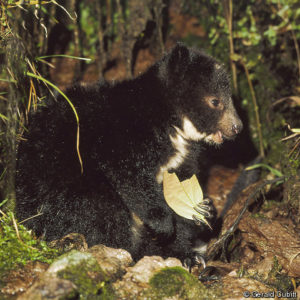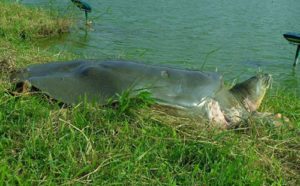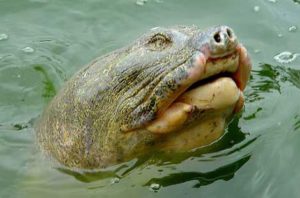Podcast: Play in new window | Download (Duration: 9:41 — 7.7MB)
It’s time to look at two more supposedly mysterious, supposedly identified animals off those “Ten Cryptozoological Animals That Have Been FOUND Please Click Please Click” articles.
First is the dingiso, or bondegezou, which is just about as adorable as an animal can get:

Next is the Hoan Kiem Turtle:

Dat FACE

Show transcript:
Welcome to Strange Animals Podcast. I’m your host, Kate Shaw.
This week we’re revisiting those “top ten cryptozoological animals found to be real!” clickbait articles that pop up online sometimes. In episode 24 we looked at two animals frequently found on those lists, so let’s examine two more today.
We’ll start in Papua New Guinea, a country that gets mentioned a lot on this podcast. I was curious, so I looked it up and now I’ve learned some geography that I desperately needed to know. Papua New Guinea is a country in the eastern half of the island of New Guinea, just north of Australia. Only Greenland is a bigger island than New Guinea, so we’re not talking a dinky little islet like the ones where cartoon shipwreck survivors end up. New Guinea has a huge mountain range, rainforests, wetlands, savannahs, coral reefs, and pretty much everything else an animal could want. More species live on New Guinea than in all of Australia. More species live on New Guinea than in all of the United States. More species live on New Guinea than in Australia and the United States combined. So it’s not surprising that new species are found there all the time.
People live on the island too, of course, and have for at least 40,000 years, probably much longer. People have lived on the island for so long, in fact, that something like 1,000 different languages are spoken there among the various tribes. The first animal we’re going to learn about today was known to the Moni tribe long before any scientists got wind of it.
The Moni people live in the remote mountainous rainforests of Papua New Guinea. I couldn’t find much information about the Moni except through Christian missionary sites, so as far as I can tell their culture was never studied before it started being influenced by outside groups. But one thing we do know is that the Moni are familiar with a black and white animal called the dingiso, or bondegezou, which holds the spirit of an ancestor. When one is encountered, it will sit up, whistle, and raise a paw in greeting.
No one outside of the Moni tribe paid any attention to this story until the 1980s, when someone sent a photograph of a dingiso to Tim Flannery, an Australian zoologist. He recognized it as a young tree kangaroo, but not one he was familiar with. In May of 1994 he led a wildlife survey expedition in the area and was able to examine a dead dingiso for himself. Sure enough, it was new to science.
The dingiso’s fur is black with white underparts and white markings on the face. Its fur is long and thick to keep it warm in the mountains, since it lives in high elevations just below the tree line. It’s about two and a half feet long, or 75 cm, not counting its tail, which doubles its length. Its face looks something like a bear’s.
Most of the information we have about the dingiso is based on what we know about other tree kangaroos, so may or may not be completely accurate. Females probably give birth to one baby at a time, which stays in its mother’s pouch while it grows. It eats leaves and fruit and lives both in trees and on the ground, although the Moni report that it spends most of its time on the ground.
The dingiso was formally described in 1995. In 2009, a BBC documentary spent eleven days searching for a dingiso with Moni tribesmen as their guides, and finally found and filmed one.
Naturally, the Moni don’t harm the dingiso, since you don’t hurt your ancestors. That has probably saved it from extinction, since the dingiso reproduces slowly and is a docile, harmless animal. Other tribes don’t have the same restriction, though, and hunt the dingiso for food. That and habitat loss due to mining and farming mean the dingiso is endangered. So little is known about it, and so few have ever been seen by scientists, that it could go extinct before we know much more about it than that it exists. But conservation organizations are working to protect it and other animals in New Guinea.
Oh, the whistling and waving activity the Moni describe is probably a threat display. But I like the Moni’s explanation better.
Our next cryptid supposedly identified is the Hoan Kiem Turtle from Vietnam. Specifically, it’s from the Hoan Kiem Lake in Hanoi. According to the story, in the early 15th century emperor Lê Lợi, a great hero who led Vietnam to independence from China, had a magical sword called Heaven’s Will. Depending on which version of the story you hear, the sword was either given to him by a god called the Dragon King, given to him by the Golden Turtle God, or was found in the lake by a fisherman and given to the emperor. One day not long after Vietnam had successfully won independence, the emperor was boating on the lake when a turtle surfaced, grabbed the sword, and disappeared with it into the lake. In other stories, the turtle surfaced and asked for the sword, and the emperor realized it was the Golden Turtle God. Hoan Kiem Lake means “Lake of the Returned Sword.”
The lake isn’t deep, only six and a half feet, or 2 m, at its deepest, and it only covers around 30 acres in the middle of a very large city. There doesn’t seem to be a metric equivalent of acre, but if hectares mean anything to you, 30 acres is a little over 12 hectares.
Softshelled turtles of enormous size have been known in the lake for a long time, specifically the Yangtze giant softshell turtle. It’s the biggest freshwater turtle known, and can measure over six feet long, or almost 2 meters. It lives in rivers and lakes in Vietnam and China and eats pretty much anything, from plants to frogs, fish, crustaceans, and snails. Its nostrils look like a tiny pig’s snout. It’s a shy turtle that doesn’t surface very often, and it’s also extremely rare, almost extinct. There may only be three or four specimens left in the world. Captive breeding has not been successful so far.
So why is the Hoan Kiem Turtle considered a cryptid? Why is it on those identified cryptid lists? Two reasons.
First of all, until its death in January of 2016, there was one in the Hoan Kiem Lake, and rumor had it that this was the same individual that had taken the emperor’s sword back in 1428. Turtles can live for a long time, but probably not for 600 years. But no one knew there was a turtle remaining in the lake after the last one was killed in 1967, not until 1998 when someone caught it on video. The turtle was captured in 2011 for treatment of some injuries, possibly caused by the lake’s pollution, then released, and lived for another five years before it was found dead in the lake.
Second, there’s some controversy regarding whether the Hoan Kiem Turtle is actually a Yangtze giant softshell turtle or a different species. Most researchers think it’s the same species. A few Vietnamese biologists think it’s not, but the DNA studies they cite to back up their claims haven’t been published formally and may not have been conducted correctly.
So while there are mysteries associated with the turtle, it’s not really accurate to call it a cryptid that’s been identified. But that doesn’t mean it’s not really interesting. I hope researchers find more of them in the wild that can be relocated to a safe area where they can breed successfully.
You can find Strange Animals Podcast online at strangeanimalspodcast.com. We’re on Twitter at strangebeasties and have a facebook page at facebook.com/strangeanimalspodcast. If you have questions, comments, or suggestions for future episodes, email us at strangeanimalspodcast@gmail.com. If you like the podcast and want to help us out, leave us a rating and review on Apple Podcasts or whatever platform you listen on. We also have a Patreon if you’d like to support us that way.
Thanks for listening!